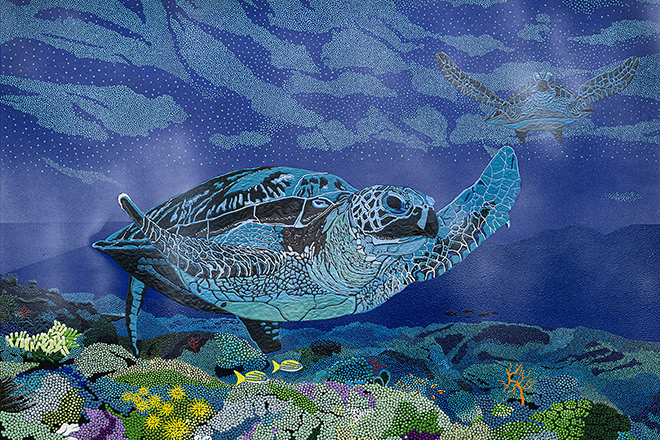Turtle Aboriginal Art
Aboriginal Turtle Art is created by coastal and river communities throughout Australia. They can be portrayed as part of the natural landscape, as an important food source, or as the Dreaming ancestor.
The Australian coastline, which has provided a continuous home to Aboriginal people for thousands of years, is often known as ‘saltwater country’. For saltwater people, all aspects of social, cultural, and economic life are intimately connected to the health of their coastal lands, seas and sea life.
Australia is home to an abundant variety of sea turtles that live in a range of coastal habitats. The largest population in Australia, and arguably the world, is the Great Barrier Reef. These majestic creatures are frequently depicted in Indigenous art from Queensland, the Torres Strait Islands, and around the Gulf of Carpentaria.
Certain species such as the Leatherback turtle are also commonly seen in south east Australia. Aboriginal artists such as Lloyd Gawura Hornsby, who is a salwater man from Wallaga Lakes on the south coast of NSW, depict marine scenes showing the creatures habitat, behaviour and diet.
 Artwork by internationally acclaimed artist Lloyd Hornsby Gawura
Artwork by internationally acclaimed artist Lloyd Hornsby GawuraSaltwater Turtle Art
In Arnhem Land, sea turtles were depicted in bark paintings and contemporary artists continue this tradition today. Their outline is usually captured from an aerial perspective and sometimes fine crosshatching designs, known as rarrk, are used to infill the shape.
One dreamtime story that generations of artists have captured on bark is the Bremer Island turtle man. It tells of two ancestral hunters that harpooned Dhalwatpu the large saltwater animal and prepared in the traditional way on Ruwakpuy Beach.
The story highlights the great respect for this creature, and the ceremonial processes that are involved in hunting, preparing and cooking it. The story also illustrates the dire consequences for those that do not follow traditional law.
Turtle Shell Art
As well as an important food source, the shell was utilized by Aboriginal people in a variety of ways. Torres Strait Islanders are the only culture in the world to make elaborate turtle shell masks for ceremonies.
Some of the ceremonies were to initiate boys, while others were to help send the spirits of the recently deceased to the island of the dead. Contemporary Torres Strait Islander artists use these traditional masks as a key point of reference in their own art practice which can vary from painting, prints, sculpture and performance art.
Freshwater Turtle Art
Communities along the great riverways in the Northern Territority and the Kimberleys depict freshwater turtles. It is another important food source and the animal’s movements can signal the change in seasons.

Artworks by Paddy Fordham Wainburranga
Ancient rock art in the top end depicts the ancestral being or the creature in part of a hunting scene in natural ochre pigments. Sometimes it is represented in the x-ray style, showing some anatomical features. Contemporary Aboriginal artists today may continue to use the x ray style and a traditional ochre colour palette or use the dot painting style and bright colours.
Koori, Ngarrindjeri, and Noongar artists sometimes depict the long neck turtle in their paintings, works on paper or cultural objects. They were part of the staple diet and are easily distinguishable by their long neck. Sometimes artists depict the animal bending its neck it odd shapes. This is because it bends its head sideways into its shell rather than pulling it directly back.
Our art gallery has a wonderful range of turtle aboriginal art as well as many other native Australian animals depicted in a wide variety of styles. They are of great charm and presence and are ready to hang in a multitude of home or corporate settings.
